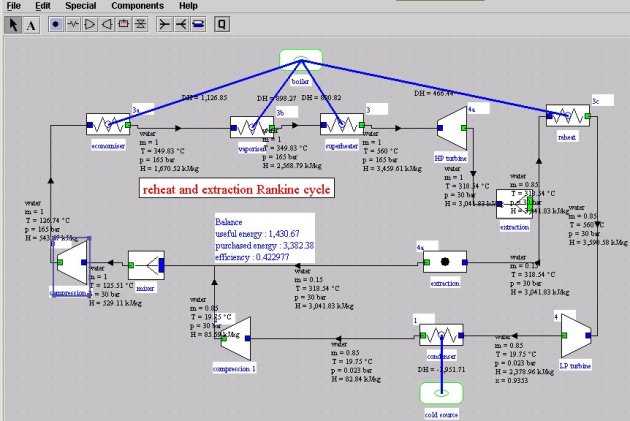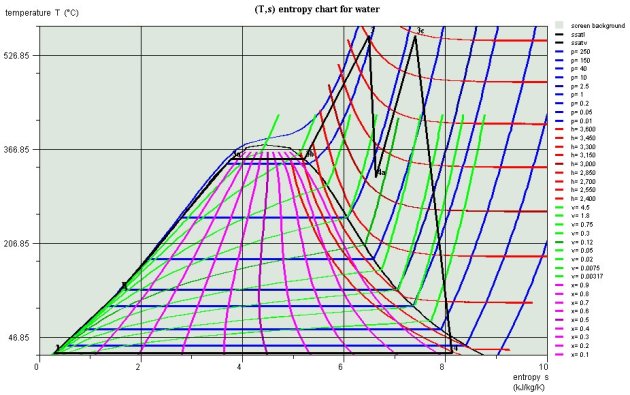The Thermoptim® software
While the analysis of energy technologies and thermodynamics is commonly viewed as challenging, it becomes significantly more straightforward by segregating the overall system description, usually a relatively simple task, from the examination of individual components considered one by one.
The comprehensive description proves highly beneficial at a qualitative level, providing a visual representation that aids in comprehending the role of each component within the entire system. From an instructional perspective, grasping the design principles of these technologies is fundamentally important. Once the overall structure of an engine or refrigeration device is well understood, delving into the study of individual components becomes much more manageable, as one is aware of their integration in the system and their respective functions.
With access to a suitable graphical environment, such as the one provided in Thermoptim, the internal structure of any system can be effortlessly described. The qualitative or diagrammatic representation obtained is rich in engineering information, which can later be quantified by configuring the numerical thermodynamic parameters of the various components. Thanks to this innovative approach that separates qualitative and quantitative aspects, users of Thermoptim can effortlessly calculate even complex thermodynamic systems without the need to write equations or program a single line of code.
Initially, Thermoptim was developed to address challenges in teaching applied thermodynamics. Its current functionalities extend its utility to solving much more intricate problems, including industrial schematic design. For example, it has been employed in the system integration of cogeneration units and advanced electricity generation production plants involving several hundred components.
A generic modeling environment
The Thermoptim software provides a modeling environment including four closely interconnected working elements : a diagram editor / synoptic screen (figure above), a simulator, interactive charts (figure below), and an optimization tool, allowing one to easily vary the whole set of characteristics of the system under investigation.
Given that energy conversion technologies can be depicted as an assembly of interconnected components, their system analysis can be founded on a hybrid approach involving both steady-state thermodynamic modeling of its various elements and a tailored system design for the specific project. This approach allows for a comprehensive exploration, bringing to the forefront the main functional elements and their interconnections within the studied project.
To perform these calculations, one requires the following:
Each functional element represented by a corresponding Thermoptim basic type (substance, point, process, node, heat exchanger), each having its unique characteristics and coupling variables.
The entire system model, assembled by utilizing these types through an interactive interface.
System simulation of the entire model facilitated by an automatic recalculation engine. This engine leverages the system properties implicitly described during the initial modeling of the system.
Thermoptim has been developed to address challenges associated with the learning and enhanced comprehension of applied thermodynamics. Its objectives are as follows:
to motivate beginners by circumventing initial calculation difficulties while allowing them to explore examples complex enough to represent real-world cases (currently utilized in approximately 120 higher education institutes);
and to offer advanced users a robust calculation environment that enhances their productivity.
Applied thermodynamics is indeed a relatively complex science, as the physical laws involved are highly nonlinear. Thermodynamic fluids fall into two categories: ideal gases or vapors. Modeling ideal gases is relatively straightforward compared to vapors, as the latter are governed by more complex equations. These fluids undergo various transformations, which are also nonlinear, ranging from simple processes like compressions or expansions to more intricate ones involving compositional changes, such as combustion or moist gas condensations. Depending on the scenario, these processes must be calculated in open or closed systems, with the equations differing accordingly.
Main functions of the software
Thermoptim allows one to calculate the complete state of different fluids (temperature, pressure, mass volume, enthalpy, internal energy, entropy, exergy and quality), for ideal gases and condensable vapors. These fluids can undergo various transformations or processes:
compression and expansion, in open or closed systems. These can be adiabatic or polytropic, and are characterized by their isentropic or polytropic efficiency ;
combustion, also in a closed or open system, at set pressure, volume or temperature. Fuel can be introduced into the combustion chamber separately from the oxidizer, or premixed. The dissociation of the carbon dioxide can be taken into account ;
isenthalpic throttling ;
heat exchanges with other fluids: the software is able to calculate the UA product or the overall heat transfer coefficient across the surface of a heat exchanger for the following configurations: counter flow, parallel flow, cross flow or (p-n) type.
Fluid networks are represented by nodes (mixers, dividers and separators), which conserve enthalpy and mass flow-rate. The other elements (compressors, turbines, combustion chambers, heat exchangers) can be easily connected into these networks.
Fluid mixtures can be made. These are considered to be ideal gases. Specifically, Thermoptim allows one to process water vapor / gas mixtures and provides six types of processes to study them (heating, cooling, humidification, supply conditions, desiccation).
The software possesses a database of thermophysical properties of substances most commonly used in applied thermodynamics. The whole set of elements composing the system studied is grouped as a project which can be handled thanks to appropriate interfaces.


